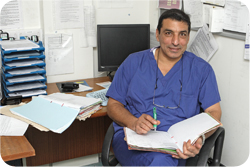Breast Unit
Axillary Lymph Node Dissection
Axillary Lymph Node Dissection
 Mr Hassan El-Wakeel |
On this page: The Operation Complications After Care |
The Operation
This operation entails removing most or all of the lymph nodes in the axilla (or armpit).
It is an operation that is commonly undertaken at the same time as the surgery to remove the cancer in the breast. It is performed if we already know that the breast cancer cells have spread from the breast to the lymph nodes in the armpit. In this situation the operation is an important part of the treatment for breast cancer by controlling the growth of the disease in the armpit.
In many respects an axillary lymph node dissection is a more detailed and more difficult procedure to undertake than the breast part of the operation. There are a lot of important structures in the armpit that the surgeon must be very careful of to avoid damage.
Complications
You may feel some discomfort following the surgery, especially in the first few days following the operation.
Despite this, the vast majority of patients recover well and quickly from this operation and most do not develop problems, side effects or complications.
However, it is clear that the operation of axillary node dissection does have a number of drawbacks and possible side effects – such as discomfort, early reduced shoulder movement, altered sensation to the upper inner aspect of the arm and a small chance of subsequently developing lymphoedema(symptomatic rate of around 20%).
Lymphoedema - Causes and Prevention
Link opens in a new window
After Care
After your operation, fluid may collect around your wound. In order to reduce this, a drain may be put in place which is attached to a collection bag. The drain is usually removed a few days after your operation. In some cases, you may wish to go home with the drain still in place and your Breast Clinical Nurse Specialist (BCNS) will discuss this with you and give you all the information you need.
Your wound is usually covered by an adhesive dressing and the stitches generally dissolve.
Any discomfort in your arm/shoulder should improve within a few weeks and you will be encouraged to do simple arm exercises regularly for at least eight weeks after the operation.
When you return home,slowly increase your physical activity each day. You can expect to feel tired for several months after your operation.
It is important to follow the advice given by your BCNS regarding the care of your arm forever, in order to reduce the risk of developing lymphoedema.
Please do not hesitate to contact your BCNS if you have any concerns after you return home.
Also See:
Wide Local Excision (Lumpectomy)
Needle Localised wide local excision
Mastectomy without reconstruction


